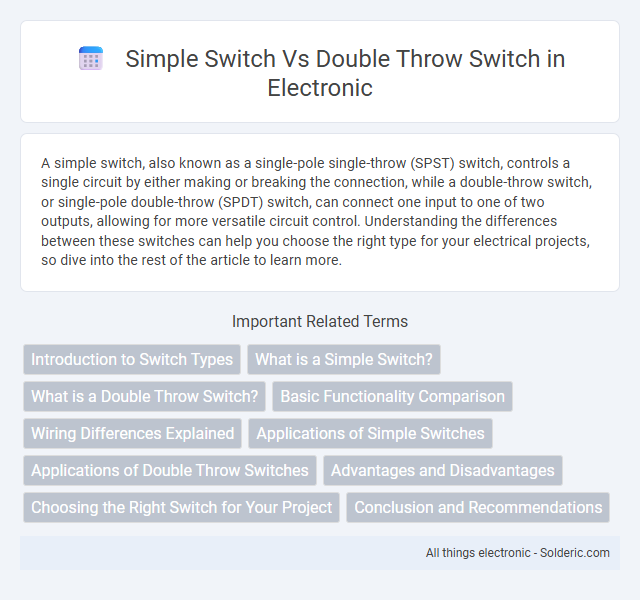A simple switch, also known as a single-pole single-throw (SPST) switch, controls a single circuit by either making or breaking the connection, while a double-throw switch, or single-pole double-throw (SPDT) switch, can connect one input to one of two outputs, allowing for more versatile circuit control. Understanding the differences between these switches can help you choose the right type for your electrical projects, so dive into the rest of the article to learn more.
Comparison Table
| Feature | Simple Switch (SPST) | Double Throw Switch (SPDT) |
|---|---|---|
| Number of Poles | 1 | 1 |
| Number of Throws | 1 | 2 |
| Function | Connects or disconnects a single circuit | Switches a single input between two outputs |
| Common Application | On/off control | Selecting between two circuits or devices |
| Contact Configuration | Single pole, single throw | Single pole, double throw |
| Example | Light switch | Change input source |
Introduction to Switch Types
A simple switch, known as a Single Pole Single Throw (SPST) switch, controls a single circuit by opening or closing it, making it ideal for basic on/off functions. In contrast, a Double Throw Switch, such as a Single Pole Double Throw (SPDT) switch, allows the connection of a single input to one of two outputs, enabling the selection between two circuits. These fundamental differences in switch types determine their applications in electronic and electrical systems.
What is a Simple Switch?
A simple switch, also known as a single-pole single-throw (SPST) switch, controls the flow of electricity by either opening or closing a single circuit. It has two terminals and functions as an on/off control to connect or disconnect power. Your choice of a simple switch is ideal for basic applications requiring straightforward circuit interruption.
What is a Double Throw Switch?
A double throw switch is an electrical component that allows current to flow through one of two different circuits, enabling the user to toggle between two outputs from a single input. Unlike a simple switch that only opens or closes a circuit, a double throw switch features three terminals: one common terminal and two output terminals, facilitating the selection between two separate paths. This switch type is commonly used in applications requiring circuit direction control, such as in audio equipment or motor control systems.
Basic Functionality Comparison
A simple switch, or single-pole single-throw (SPST) switch, controls a single circuit by opening or closing it, allowing power to flow or stopping it. A double throw switch, often single-pole double-throw (SPDT), redirects current between two separate circuits, providing an option to connect to either one. Understanding this basic functionality ensures you select the correct switch type for your electrical application, optimizing control and circuit management.
Wiring Differences Explained
A simple switch, also known as a single-pole single-throw (SPST) switch, has two terminals and operates by opening or closing a single circuit. In contrast, a double throw switch, such as a single-pole double-throw (SPDT) switch, features three terminals and allows you to connect one input to one of two outputs, enabling circuit direction control. The wiring of an SPST is straightforward with just one input and one output wire, whereas the SPDT requires additional wiring to manage the alternate connection paths effectively.
Applications of Simple Switches
Simple switches are commonly used in everyday applications such as controlling household lighting, powering small electronic devices, and operating basic appliances. Their straightforward on/off functionality makes them ideal for circuits requiring a single connection point to open or close. These switches are also prevalent in automotive and industrial settings where simple control mechanisms are sufficient.
Applications of Double Throw Switches
Double throw switches are widely used in applications requiring the control of two different circuits from a single input, such as in audio device input selection and power source switching between battery and mains. They play a crucial role in electric signal routing and logic circuit design, enabling seamless circuit transitions without the need for multiple switches. Industrial automation systems frequently utilize double throw switches to ensure operational flexibility and reliability in controlling machinery and process flows.
Advantages and Disadvantages
A simple switch offers straightforward on/off control with easy installation and lower cost, making it ideal for basic circuits; however, it lacks versatility in routing current to multiple outputs. A double throw switch allows you to toggle a single input between two outputs, enhancing functionality for complex wiring needs but increasing complexity and cost. Your choice depends on whether simplicity or flexibility is a priority in your electrical application.
Choosing the Right Switch for Your Project
Choosing the right switch for your project depends on the complexity of your circuit and the number of output paths needed. A simple switch, such as a Single Pole Single Throw (SPST), is ideal for straightforward applications that require just an on/off function. Your project will benefit from a Double Throw Switch, like Single Pole Double Throw (SPDT), when you need to alternate between two different circuits or devices with one input.
Conclusion and Recommendations
A simple switch, also known as a single-pole single-throw (SPST) switch, offers straightforward on/off control, making it ideal for basic electrical circuits and low-complexity applications. A double-throw switch, or single-pole double-throw (SPDT) switch, provides versatile circuit control by allowing one input to connect to two outputs, making it suitable for applications requiring circuit selection or changeover functions. For projects demanding simplicity and cost-efficiency, an SPST switch is recommended, while SPDT switches are recommended for scenarios needing flexible circuit routing or multi-function control.
simple switch vs double throw switch Infographic

 solderic.com
solderic.com